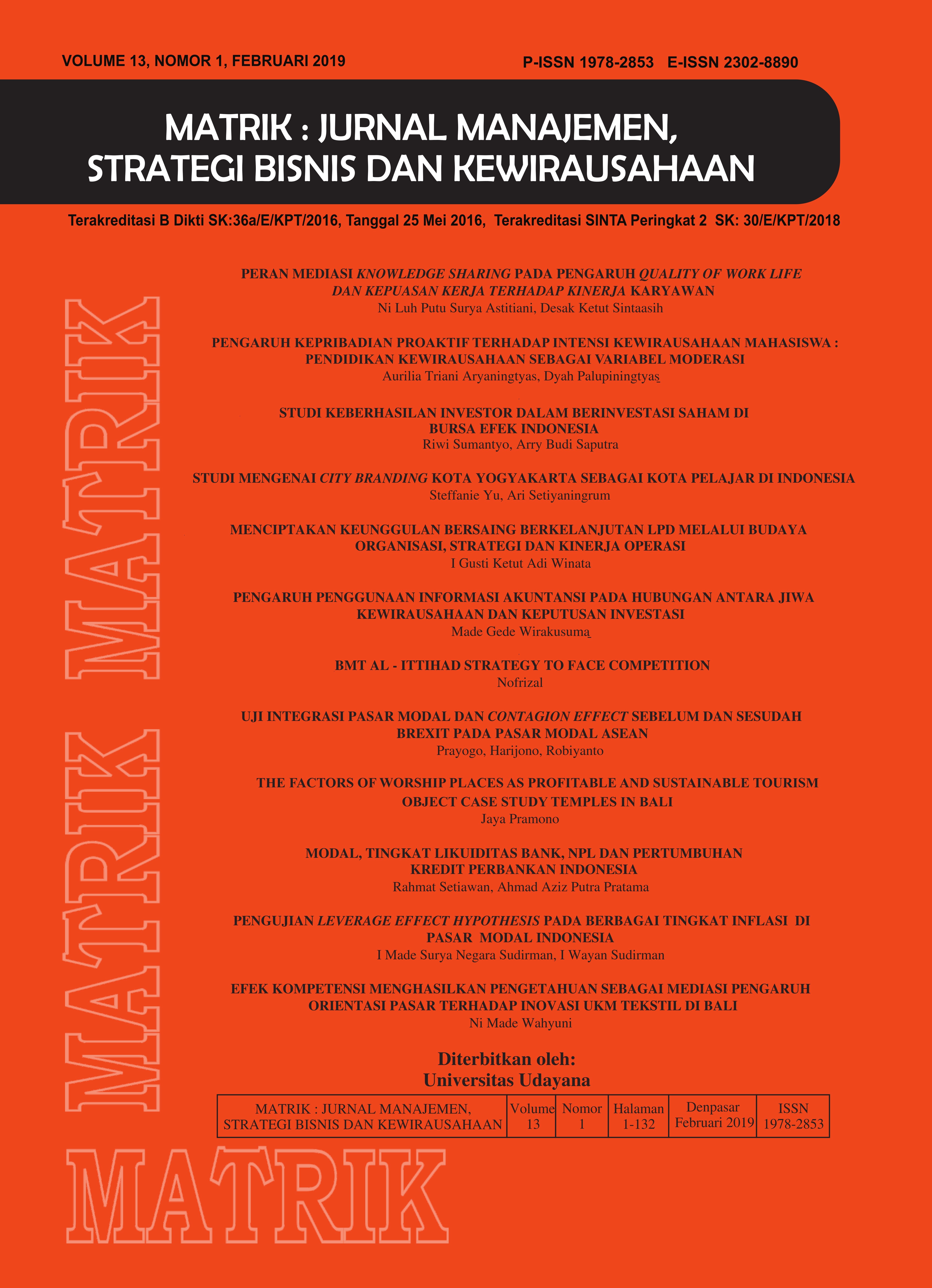STUDI MENGENAI CITY BRANDING KOTA YOGYAKARTA SEBAGAI KOTA PELAJAR DI INDONESIA
Abstract
Penelitian ini bertujuan untuk menganalisis pengaruh attitude toward brand, brand uniqueness, dan brand personality terhadap self-brand connection serta pengaruh self-brand connection terhadap brand advocacy. Penelitian ini juga menganalisis peran mediasi self-brand connection pada pengaruh attitude toward brand, brand uniqueness, dan brand personality terhadap brand advocacy. Pengumpulan data dilakukan dengan metode survei melalui pendistribusian kuesioner pada 128 responden mahasiswa pendatang yang mengambil studi di kota Yogyakarta. Metode pengambilan sampel yang digunakan adalah non-probability sampling dengan teknik purposive sampling. Dengan menggunakan model persamaan struktural dengan software statistik AMOS, penelitian ini menemukan bahwa attitude toward brand, brand uniqueness dan brand personality berpengaruh positif pada self-brand connection serta self-brand connection berpengaruh positif terhadap brand advocacy. Self-brand connection juga terbukti memediasi pengaruh attitude
toward brand, brand uniqueness, dan brand personality terhadap brand advocacy.
Kata Kunci: attitude toward brand, brand uniqueness, brand personality, self-brand connection, brand advocacy
Downloads
References
Anholt. 2010. Definitions of place branding – Working towards a resolution. Place Branding and Public Diplomacy (Macmillan Publishers Ltd), 6(1), 1–10.
Ashworth, G., & Kavaratzis, M. 2009. Beyond the logo: Brand management for cities. Journal of Brand Management, 16(8), 520-531.
Berry, L.L. 2000. Cultivating service brand equity. Journal of the Academy of Marketing Sciences, 28(1), 128-137.
Braun, E. 2008. City marketing: Towards an integrated approach. ERIM PhD Series in Research and Management, 142. Erasmus Research Institute of Management (ERIM), Rotterdam. http://hdl handle.net/1765/13694
Braun, E. 2012. Putting city branding into practice. Journal of Brand Management, 19(4), 257-267.
Dinnie, K. 2011. City branding: Theory and cases. Place Branding and Public Diplomacy, 7(3), 218-222.
Escalas, J.E. 2004. Narrative processing: Building consumer connections to brands. Journal of Consumer Psychology, 14(1&2), 168-180.
Fullerton, G. 2003. When does commitment lead to loyalty? Journal of Services Research, 5(4), 333-344.
Ghozali, I. 2011. Aplikasi Analisis Multivariate Dengan Program SPSS. Semarang: Badan Penerbit Universitas Diponegoro.
Hair Jr, J.F., Black, W.C., Babin, B.J., & Tatham, R.L. 2006. Multivariate Data Analysis. 6th Edition. Upper Saddle River, NJ: Pearson Prentice Hall.
Hankinson, G. 2004. The brand image of tourism destinations: A study of the saliency of organic images. Journal of Product & Brand Management, 13(1), 6-14.
Kavaratzis, M. 2004. From city marketing to city branding: Towards a theoretical framework for developing city brands. Place Branding (Henry Stewart Publications), 1(1), 58-73.
Kavaratzis, M. 2007. City marketing: The past, the present and some unresolved issues. Geography Compass, 1(3), 695-712.
Kavaratzis, M. 2008. From City Marketing to City Branding: An Interdisciplinary Analysis with Reference to Amsterdam, Budapest and Athens. University of Groningen.
Kavaratzis, M. 2009. Cities and their brands: Lessons from corporate branding. Place Brandingand Public Diplomacy, 5(1), 26-37.
Keller, K.L. 1993. Conceptualizing, measuring, and managing customer-based brand equity. Journal of Marketing, 57(1), 1-22.
Keller, K.L. 1998. Strategic Brand Management: Building, Measuring and Managing Brand Equity. Upper Saddle River, NJ: Prentice-Hall.
Kemp, E., Childers, C.Y., & Williams, K.H. 2012a. A tale of a musical city: Fostering self-brand connection among residents of Austin, Texas. Place Branding and Public Diplomacy, 8(2), 147-157.
Kemp, E., Childers, C.Y., & Williams, K.H. 2012b. Place branding: Creating self-brand connections and brand advocacy. Journal of Product and Brand Management, 21(7), 508-515.
Kemp, E., Fillapalli, R., & Becerra, E. 2014. Healthcare branding: Developing emotionally based consumer brand relationships. Journal of Services Marketing, 28(2), 126-137.
Kim, C.K., Han, D., & Park, S.B. 2001. The effect of brand personality and brand identification on brand loyalty: Applying the theory of social identification. Japanese Journal of Psychological Research, 43(4), 195-206.
Kim, H. R., Lee, M., & Ulgado, F.M. 2005. Brand personality, self-congruity and the consumer-brand relationship. Paper Presented at the Asia Pacific Advances in Consumer Research.
Kline, R. B. 2011. Principles and Practice of Structural Equation Modeling. 3rd Edition. New York: The Guilford Press.
Low, G.S., & Lamb, C.W. 2000. The measurement and dimensionality of brand associations. Journal of Product & Brand Management, 9(6), 350-368.
Medway, D., & Warnaby, G. 2008. Alternative perspectives on marketing and the place brand. European Journal of Marketing, 42(5/6), 641-653.
Moons, I., & de Pelsmacker, P. 2015. Self-brand personality differences and attitudes towards electric cars. Sustainability, 7, 12322-12339.
Pike, S. 2005. Tourism destination branding complexity. Journal of Product & Brand Management, 14(4), 258-259.
Rainisto, S. K. 2003. Success factors of place marketing: A study of place marketing practices in Northern Europe and the United States. Published Doctoral Dissertation, Helsinki University of Technology, Institute of Strategy and International Business, Finland.
Sahin, S. & Baloglu, S. 2014. City branding: Investigating a brand advocacy model for distinct segments. Journal of Hospitality Marketing & Management, 23(3), 239-265.
Van den Berg, L., & Braun, E. 1999. Urban competitiveness, marketing and the need for organising capacity. Urban Studies, 36(5/6), 987-999.
Wee, T.T.T. 2004. Extending human personality to brands: The stability factor. Journal of Brand Management, 11(4), 317-330.
Wijanto, S.H. 2008. Structural Equation Modelling Dengan Lisrel, Konsep dan Tutorial. Jakarta: Graha Ilmu.
Yananda, M Rahmat. 2014. Branding Tempat: Membangun Kota, Kabupaten dan Provinsi Berbasis Identitas. Jakarta: Makna Informasi.
Zenker, S. 2009. Who’s your target? The creative class as a target group for place branding. Journal of Place Management and Development, 2(1), 23-32.
http://telusur.metrotvnews.com, Dari Taman Siswa Hingga Kota Pelajar, diakses tanggal 14 Oktober 2016.
http://nationalgeographic.co.id, Mengenang Kembali Sejarah Hari Pendidikan Nasional di Indonesia, diakses tanggal 17 Oktober 2016.
http://www.pendidikan-diy.go.id, Sejarah Singkat Daerah Istimewa Yogyakarta, diakses tanggal 14 Oktober 2016.
https://news.idntimes.com,Pemandangan Seperti Ini yang Bakal Kamu Sering Lihat di Yogyakarta!,diakses tanggal 14 Oktober 2016.
https://www.ama.org, Dictionary Brand, diakses tanggal 19 Oktober 2016.
https://ayokuliah.id, 11 Perguruan Tinggi Terbaik di Yogyakarta Tahun 2016, diakses tanggal 18 Desember 2016.
http://www.danielsoper.com, Sobel Test Calculation, diakses tanggal 12 Januari 2016.
Keywords
 This work is licensed under a Creative Commons Attribution-ShareAlike 4.0 International License.
This work is licensed under a Creative Commons Attribution-ShareAlike 4.0 International License.

















